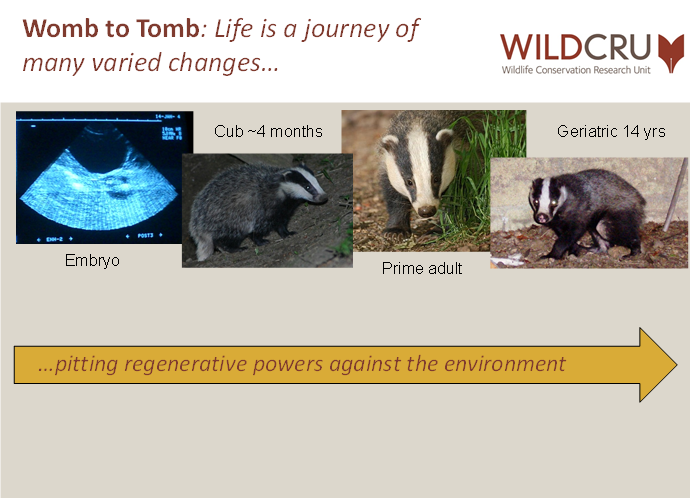News
Telomeres
One of the great mysteries of life, and a driving force in evolutionary ecology, is that we wear out. This distressing reality afflicts the badgers of Wytham Wood as much as it does the WildCRU team that studies them.
Cell regeneration, that keeps the body functional and healthy, gradually becomes less efficient until tissues and organs fail, eventually fatally. This loss of performance with age is termed ‘senescence’, and, intriguingly (if frustratingly) it happens at a different rate in different individuals; indeed, the process is oddly inconsistent – which goes first, the hair or the teeth… or the insulin? This topic is so intriguing, exciting and topical that our badger team has delved deeply into it, as revealed in a new publication: Molecular Ecology.
First, some background. Senescence is a complex process, but at the cellular level a lot comes down to telomere length. Telomeres are the ‘book ends’ that prevent the ends of the two chromosome strands sticking together during cell division, and protect genetic information because a short piece of each chromosome is lost every time DNA is replicated. As a consequence of replicative cycles, telomeres shorten with age, especially during development when cell division is rapid, but also in response to metabolically demanding activities, such as reproduction, or coping with stress or disease. This allows the DNA in the chromosome to ‘unravel’ and get entangled. Telomeres can, however be replenished by something called ‘telomerase’, although the production of this enzyme is much reduced ( transcriptionally repressed) later in life. Nevertheless, ultimately telomere attrition leads to a state of cellular arrest, when cells can no longer replicate, and these accumulating ‘dead’ cells ultimately impair tissue functioning.
In 1986 David Macdonald began WildCRU’s long term programme monitoring all the births, deaths and marriages of badgers in Wytham Woods, and so we an archive of blood samples stretching over 24 cohorts. In the spirit of intergenerationality, we worked with the graduate student of one of our own former graduate students, namely Sil van Lieshout, co-supervised by our alumna Dr. Hannah Dugdale, now at the University of Leeds. Sil delved into our archive, which is surely unique for a medium-sized mammal and looked at the DNA found in white blood cells, termed leukocytes.
Curiously, we found a complex cross‐sectional relationship between telomere length and age in both sexes. There was no apparent loss over the first 29 months, then an increase (of up to 6% length) until 65 months, but with a decline to 112 months. Individuals with longer telomeres prior to age one year had longer lifespans, such that an increase of one unit length was associated with 13.3% greater longevity. Telomere length in early‐life only predicted survival to maturity; thereafter it did not predict survival to the following year, nor adult survival probability.
That we observed increases in telomere length within individuals was particularly interesting, suggesting that perhaps telomerase enzymes were able to replenish telomeres, thus some capacity to resist the Grim Reaper. Importantly, we found considerable differences between cohorts, signifying that the early-life environmental stress (disease, starvation) prevailing each spring could affect how life-histories unfold at the cellular level; a finding with considerable ecological implications.
For more details on these intricacies, see our full paper in Molecular Ecology.
van Lieshout, S. H., Bretman, A., Newman, C., Buesching, C. D., Macdonald, D. W., & Dugdale, H. L. (2019). Individual variation in early‐life telomere length and survival in a wild mammal. Molecular Ecology, vol 28 (issue 18),p 4152.






